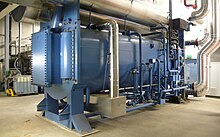Absorption heat pump
Absorption heat pump is essentially an air-source heat pump driven not by electricity, but by a heat source such as solar-heated water, or geothermal-heated water. There are also absorption coolers available that work on the same principle, but are not reversible and cannot serve as a heat source.

Solar thermal
Single, double or triple iterative absorption cooling cycles are used in different solar-thermal-cooling system designs. The more cycles, the more efficient they are.
In the late 19th century, the most common phase change refrigerant material for absorption cooling was a solution of ammonia and water. Today, the combination of lithium bromide and water is also in common use. One end of the system of expansion/condensation pipes is heated, and the other end gets cold enough to make ice. Originally, natural gas was used as a heat source in the late 19th century. Today, propane is used in recreational vehicle absorption chiller refrigerators. Innovative hot water solar thermal energy collectors can also be used as the modern "free energy" heat source.
Efficient absorption chillers require water of at least 190 °F (88 °C). Common, inexpensive flat-plate solar thermal collectors only produce about 160 °F (70 °C) water, but several successful commercial projects in the US, Asia and Europe have shown that flat plate solar collectors specially developed for temperatures over 200 °F (featuring double glazing, increased backside insulation, etc.) can be effective and cost efficient.[1] Evacuated-tube solar panels can be used as well. Concentrating solar collectors required for absorption chillers are less effective in hot humid, cloudy environments, especially where the overnight low temperature and relative humidity are uncomfortably high. Where water can be heated well above 190 °F (88+ °C), it can be stored and used when the sun is not shining.
For 150 years, absorption chillers have been used to make ice (before the electric light bulb was invented).[2] This ice can be stored and used as an "ice battery" for cooling when the sun is not shining, as it was in the 1995 Hotel New Otani Tokyo in Japan.[3] Mathematical models are available in the public domain for ice-based thermal energy storage performance calculations.[4]
Other
By using a fuel cell as opposed to a burner to create heat, it would be theoretically possible to create an air-conditioner which converted approximately 55% of the fuel (assuming a methane fuel cell) to electricity and the rest to driving an air-conditioner.[citation needed]
See also
References
- ^ "Solar Cooling." www.solid.at. Accessed on 1 July 2008
- ^ Gearoid Foley; Robert DeVault; Richard Sweetser. "The Future of Absorption Technology in America" (PDF). U.S. DOE Energy Efficiency and Renewable Energy (EERE). Archived from the original (PDF) on 28 November 2007. Retrieved 2007-11-08.
{{cite web}}: Unknown parameter|deadurl=ignored (|url-status=suggested) (help) - ^ "Ice-cooling System Reduces Environmental Burden". The New Otani News. New Otani Club International members. 2000-06-28. Archived from the original on 7 October 2007. Retrieved 2012-05-03.
{{cite web}}: Unknown parameter|deadurl=ignored (|url-status=suggested) (help) - ^ "Development of a thermal energy storage model for EnergyPlus" (PDF). 2004. Retrieved 2008-04-06.
